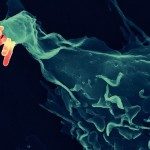Lien vers Pubmed [PMID] – 21029766
Biochim. Biophys. Acta 2011 Mar;1810(3):297-307
BACKGROUND: A common strategy of microbial pathogens is to invade host cells during infection. The invading microbes explore different intracellular compartments to find their preferred niche.
SCOPE OF REVIEW: Imaging has been instrumental to unravel paradigms of pathogen entry, to identify their exact intracellular location, and to understand the underlying mechanisms for the formation of pathogen-containing niches. Here, we provide an overview of imaging techniques that have been applied to monitor the intracellular lifestyle of pathogens, focusing mainly on bacteria that either remain in vacuolar-bound compartments or rupture the endocytic vacuole to escape into the host’s cellular cytoplasm.
MAJOR CONCLUSIONS: We will depict common molecular and cellular paradigms that are preferentially exploited by pathogens. A combination of electron microscopy, fluorescence microscopy, and time-lapse microscopy has been the driving force to reveal underlying cell biological processes. Furthermore, the development of highly sensitive and specific fluorescent sensor molecules has allowed for the identification of functional aspects of niche formation by intracellular pathogens.
GENERAL SIGNIFICANCE: Currently, we are beginning to understand the sophistication of the invasion strategies used by bacterial pathogens during the infection process- innovative imaging has been a key ingredient for this. This article is part of a Special Issue entitled Nanotechnologies – Emerging Applications in Biomedicine.

